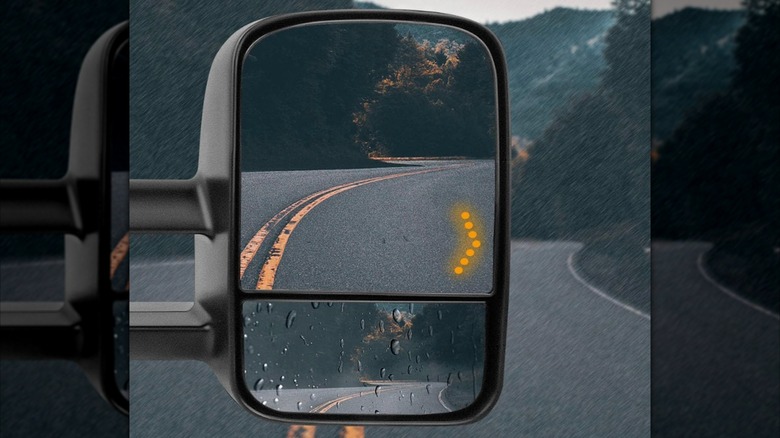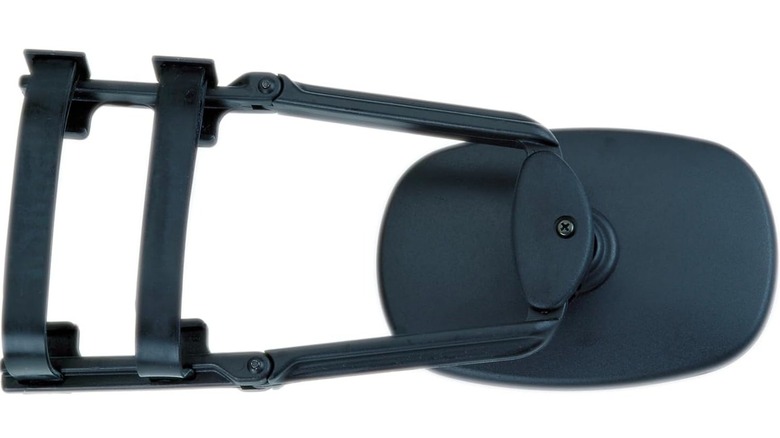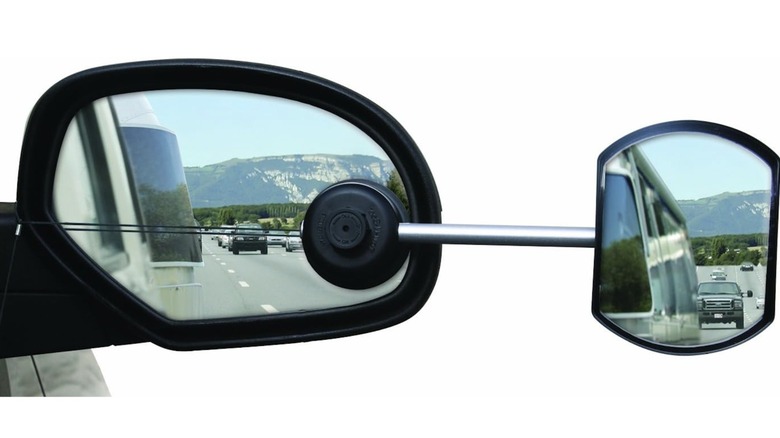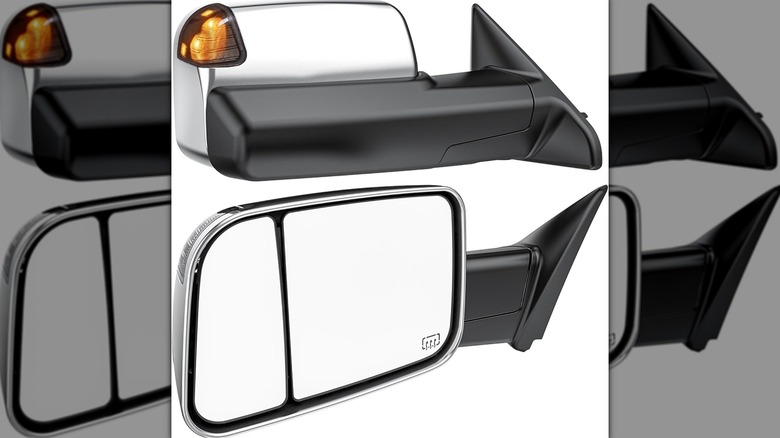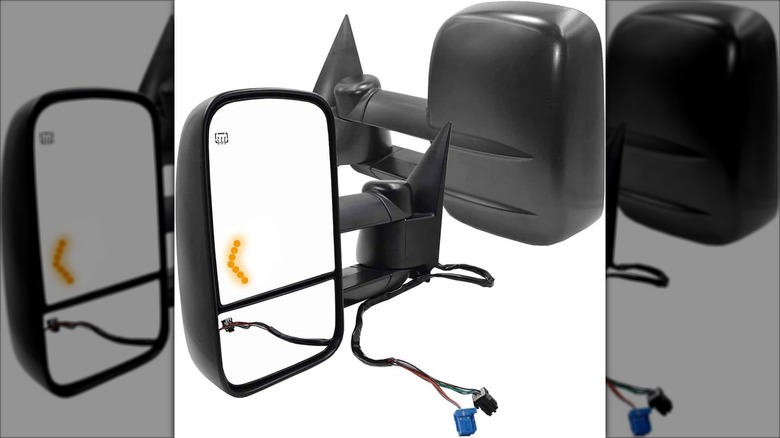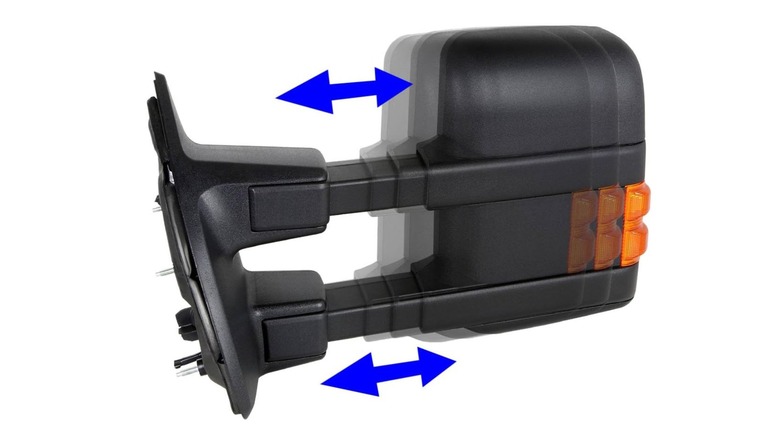The Different Types Of Tow Mirrors And How They Can Help You When Towing
We may receive a commission on purchases made from links.
Towing a trailer can make driving your vehicle trickier in numerous ways, as it affects acceleration and stopping distance and complicates turning, changing lanes, and backing up, among other things. There are some tricks to help you back up a tow trailer, but one of the safest and most efficient things you can do is add tow mirrors to your vehicle. Many car owners use supplemental mirrors or mirror accessories to help minimize blind spots, but tow mirrors are specifically designed to allow you to see further behind you, and keep a closer eye on the sides of your trailer, and any obstacles or vehicles around or behind it.
By extending out further than standard side-view mirrors, tow mirrors provide the additional visibility you need to make sure the trailer and anything on it remain stable and secure as you drive. They're also invaluable when backing up to hitch a trailer or parking once it's attached. Not only do tow mirrors make things safer and more convenient, but in many jurisdictions, if you're hauling something large enough, it's required by law to equip your vehicle with tow mirrors.
What kind of tow mirror you use may come down to your personal preference — or budget, as they can range in price from $20 to around $1,000, though the latter would typically involve custom work. There are different types of tow mirrors based on how you can attach them to your vehicle, as well as control them. Here's a breakdown of the options out there.
Clip-on and Clamp-on Mirrors
One of the most commonly used tow mirrors are the clip-on type, which are exactly what they sound like. As you're just clipping them on to your vehicle's existing side-view mirrors, they're easier to attach and remove than other types of tow mirrors. This not only makes it more convenient for you, but is ideal if you only hitch a trailer every once in a while and don't need tow mirrors permanently hanging off the sides of your truck. Considering some clip-ons can be somewhat unsightly, being able to quickly remove them when you don't need them is a nice plus. It's also helpful if you're often towing with different vehicles and don't want to spend money on tow mirrors for each.
Clip-on mirrors are also generally one of the cheapest types and come in various shapes, including oval and rectangular. You can find products for around $20, or spend closer to $100. Options include the Cafopar Adjustable Clip-On Mirror Extensions, and the K-Source Universal Clip-On Towing Mirror, which is one of many unique exterior accessories for truck owners.
The downsides are that clip-on mirrors typically need to be manually adjusted, which can be a hassle — especially if multiple drivers use the vehicle. They can also obstruct the view of vehicle cameras you might also equip your truck with. Since you're attaching them directly to your side mirrors, there's also the chance they could chip or damage your car's paint. Clip-ons are also less secure than other types of tow mirrors and could potentially shake loose on bumpier terrain. Clamp-on mirrors are a similar type of tow mirror that are a little more secure, though take a bit more effort to install.
Snap, Strap, and Suction mirrors
Snap tow mirrors are similar to clip-on and clamp-on mirrors, though they are molded to perfectly fit specific vehicle designs. Often they're also designed to look similar to the OEM side mirrors so that they appear as natural extensions of your truck, as opposed to obvious accessories. If you purchase a snap-on tow mirror, make sure it's compatible with your truck model — this K-Source Snap & Zap Mirror, for example, is built specifically for a Ford F-150.
Besides clipping, clamping, or snapping, you can also strap on certain kinds of tow mirrors using elastic bands. The Curt Universal Strap-On Adjustable Extendable Towing Mirror can be attached horizontally or vertically and extends between 5 and 7.5 inches, allowing you to adjust it for best use with the size of your truck and trailer.
Another way to easily attach tow mirrors to your existing ones is by using powerful suction types, which adhere to the glass face of your side mirrors rather than their housing. One advantage to suction tow mirrors — such as the Camco Flat Tow-N-See Mirror — is that, if you can electronically adjust the angle of your side mirrors from inside your vehicle, you'll also be able to do the same with the attached additional mirrors. However, unlike strap-on or snap-on tow mirrors, suction models obscure part of your main side mirror, creating potentially-dangerous blind spots — so be smart about where you place them. You'll also want to double check user reviews and make sure the suction of the tow mirror you purchase is up to the task of staying firmly adhered to your vehicle at all times.
Power Tow Mirrors
There are also tow mirrors that can be directly controlled electronically, allowing you to adjust their angles quickly and on the fly. Rather than attaching to your side mirrors like their manual counterparts, power tow mirrors usually are meant to be full replacements and involve connecting their wires and electronic components to your vehicle's power mirror system through the car door. You can do this yourself if you're confident enough to perform minor DIY work on your truck, or take it to a professional if you prefer.
Once properly attached, you can adjust power tow mirrors as easily as you would your standard side-view mirrors. Power tow mirrors are usually much more expensive than simple clip-on tow mirrors or similar. As they're integrated into your truck's power system, you'll also need to buy devices that are specifically compatible with your vehicle. Depending on the brand and model, prices can vary widely.
For example, a pair of the Sanooer Power Folding Mirrors for Sierra/Silverado sells on Amazon for $319.99, while a pair of the Whalemotor Power Heated Tow Mirrors for Dodge Ram 1500 cost $179.99. There are other ways to use electric tow mirrors without hardwiring them to your vehicle, such as clip-on mirrors that can be adjusted hands-free using an infrared remote. However, these and other power tow attachments are less common than plug-and-play power tow mirrors.
Directional Mirrors
As power tow mirrors are typically wired into your vehicle's electrical system, some models are available with lights and heated glass, just like some modern standard side-view mirrors. Certain tow mirrors can even include turn signals that are integrated either into the mirror casing or the glass itself. Of course, with useful features like these, that make towing a trailer a lot safer and more convenient, you can expect to pay more. They may also be more complicated to hardwire into your vehicle's power system and you may be more likely to rely on a professional for their proper installation.
Examples of directional mirrors include Aerdm Power Tow Mirrors and DNA Motoring Powered Foldable Towing Mirrors, which are compatible with various truck models — though you should always ensure any mirrors you buy will fit your vehicle. Both of these options are typical of directional mirrors and use bright, amber LEDs for turn signals, with the former integrating them directly into the glass and DNA Motoring's model placing them on the housing under the mirror. Both also include heated glass for defrosting and de-fogging. In addition to requiring compatibility with your specific vehicle, the manufacturers also say directional and heated tow mirrors may not work properly if your truck doesn't already feature those options on its standard OEM mirrors.
Telescoping Mirrors
Power tow mirrors and many manual models can be adjusted so that you can find the right angle to best view your trailer and its surrounding area. These mirrors typically tilt up or down, but there are also telescoping tow mirrors that allow you to more easily adjust how far they extend out from your truck, allowing you to better view the entire length of longer trailers. More importantly, the ability to telescope inward and outward allows these types to dually serve as both tow mirrors and standard side-view mirrors.
When you're not hauling a trailer behind you, you simply retract your tow mirrors to a normal length, saving you the trouble of either keeping unnecessary tow mirror attachments on your truck or having to fully remove them altogether. Since they're naturally larger than standard side mirrors, some truck owners like to use them because their bigger size better fits the silhouette of their ride.
You can typically find telescoping tow mirrors from the same retailers that sell power and manual options. Amazon sells multiple telescoping tow mirror products, including Auto Dynasty Towing Mirrors for Ford Super Duty — which are equipped with manual telescoping in addition to power adjust, heated glass, and LED turn signals — and AEagle Towing Mirrors, which provide the same features for various vehicles.
